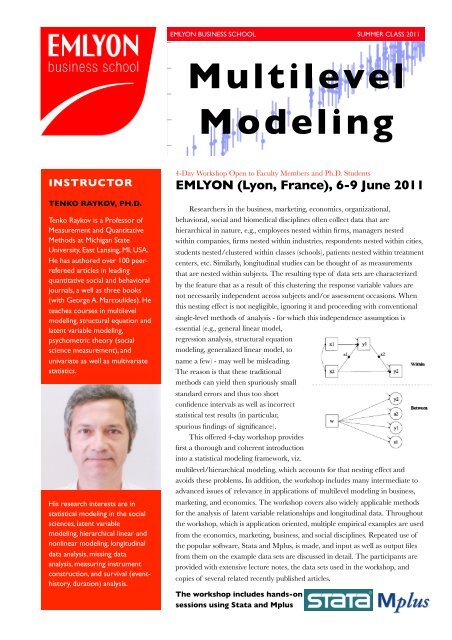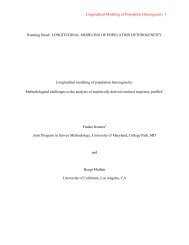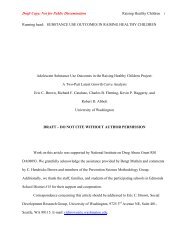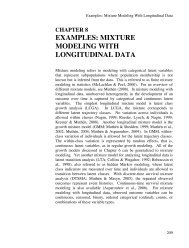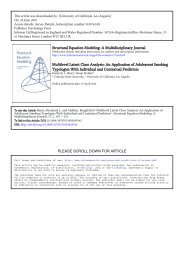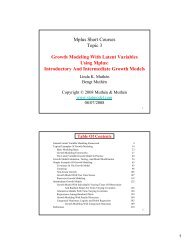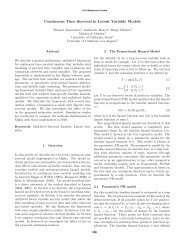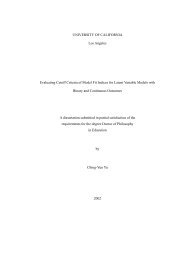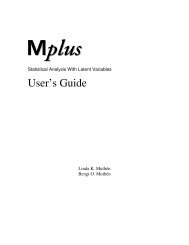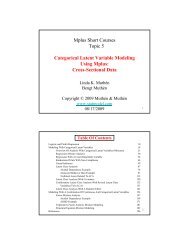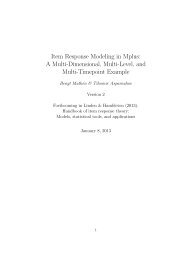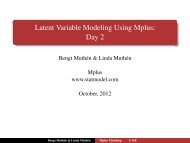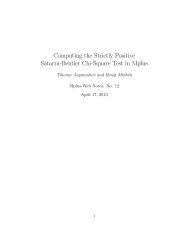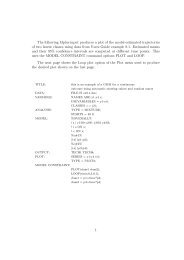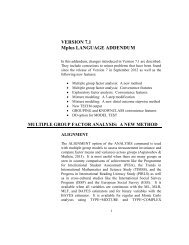Multilevel Modeling - Mplus
Multilevel Modeling - Mplus
Multilevel Modeling - Mplus
You also want an ePaper? Increase the reach of your titles
YUMPU automatically turns print PDFs into web optimized ePapers that Google loves.
EMLYON BUSINESS SCHOOL SUMMER CLASS 2011<br />
<strong>Multilevel</strong><br />
<strong>Modeling</strong><br />
INSTRUCTOR<br />
TENKO RAYKOV, PH.D.<br />
Tenko Raykov is a Professor of<br />
Measurement and Quantitative<br />
Methods at Michigan State<br />
University, East Lansing, MI, USA.<br />
He has authored over 100 peerrefereed<br />
articles in leading<br />
quantitative social and behavioral<br />
journals, a well as three books<br />
(with George A. Marcoulides). He<br />
teaches courses in multilevel<br />
modeling, structural equation and<br />
latent variable modeling,<br />
psychometric theory (social<br />
science measurement), and<br />
univariate as well as multivariate<br />
statistics.<br />
His research interests are in<br />
statistical modeling in the social<br />
sciences, latent variable<br />
modeling, hierarchical linear and<br />
nonlinear modeling, longitudinal<br />
data analysis, missing data<br />
analysis, measuring instrument<br />
construction, and survival (eventhistory,<br />
duration) analysis.<br />
4-Day Workshop Open to Faculty Members and Ph.D. Students<br />
EMLYON (Lyon, France), 6-9 June 2011<br />
Researchers in the business, marketing, economics, organizational,<br />
behavioral, social and biomedical disciplines often collect data that are<br />
hierarchical in nature, e.g., employees nested within firms, managers nested<br />
within companies, firms nested within industries, respondents nested within cities,<br />
students nested/clustered within classes (schools), patients nested within treatment<br />
centers, etc. Similarly, longitudinal studies can be thought of as measurements<br />
that are nested within subjects. The resulting type of data sets are characterized<br />
by the feature that as a result of this clustering the response variable values are<br />
not necessarily independent across subjects and/or assessment occasions. When<br />
this nesting effect is not negligible, ignoring it and proceeding with conventional<br />
single-level methods of analysis - for which this independence assumption is<br />
essential (e.g., general linear model,<br />
regression analysis, structural equation<br />
modeling, generalized linear model, to<br />
name a few) - may well be misleading.<br />
The reason is that these traditional<br />
methods can yield then spuriously small<br />
standard errors and thus too short<br />
confidence intervals as well as incorrect<br />
statistical test results (in particular,<br />
spurious findings of significance).<br />
This offered 4-day workshop provides<br />
first a thorough and coherent introduction<br />
into a statistical modeling framework, viz.<br />
multilevel/hierarchical modeling, which accounts for that nesting effect and<br />
avoids these problems. In addition, the workshop includes many intermediate to<br />
advanced issues of relevance in applications of multilevel modeling in business,<br />
marketing, and economics. The workshop covers also widely applicable methods<br />
for the analysis of latent variable relationships and longitudinal data. Throughout<br />
the workshop, which is application oriented, multiple empirical examples are used<br />
from the economics, marketing, business, and social disciplines. Repeated use of<br />
the popular software, Stata and <strong>Mplus</strong>, is made, and input as well as output files<br />
from them on the example data sets are discussed in detail. The participants are<br />
provided with extensive lecture notes, the data sets used in the workshop, and<br />
copies of several related recently published articles.<br />
The workshop includes hands-on<br />
sessions using Stata and <strong>Mplus</strong>
EMLYON BUSINESS SCHOOL SUMMER CLASS 2011<br />
<strong>Multilevel</strong> <strong>Modeling</strong><br />
Workshop, 6-9 June 2011<br />
Program<br />
VENUE<br />
EMLYON Business School<br />
23 avenue Guy de Collongue<br />
69130 Ecully, France<br />
Airport: Lyon Saint-Exupéry<br />
Train stations: Lyon Part-Dieu<br />
or Lyon Perrache<br />
GPS: 45°47'11.71" N<br />
04°45'53.63" E<br />
REGISTRATION<br />
Online registration at<br />
http://www.em-lyon.com/mm.htm<br />
FEES<br />
400 € for the full 4-day workshop<br />
A receipt and a certificate of<br />
attendance will be provided.<br />
ACCOMODATION<br />
2-star Campanile hotel accross<br />
the street. Otherwise, wide range<br />
of hotels downtown (7 km), easily<br />
reached by public transportation.<br />
See Tourist Office website at<br />
www.en.lyon-france.com/<br />
SOFTWARE<br />
Participants are expected to<br />
bring their own laptop, with both<br />
STATA and <strong>Mplus</strong> installed.<br />
A demo version of <strong>Mplus</strong> is<br />
enough for the workshop.<br />
Participants will be given a<br />
password to use the School's<br />
WiFi network.<br />
CONTACT<br />
Mrs. Catherine Perrier<br />
Assistant to the Ph.D. Program<br />
perrier@em-lyon.com<br />
+33 (0) 478 337 782<br />
Daily Arrangements<br />
09:00-10:30 Session 1: theory and applications of multilevel modeling<br />
10:30-10:45 Break<br />
10:45-12:15 Session 2: theory and applications of multilevel modeling<br />
12:15-13:15 Lunch break<br />
13:15-14:45 Session 3: theory and applications of multilevel modeling<br />
14:45-15:00 Break<br />
15:00-17:00 Hands-on session (homework given for next day)<br />
Syllabus<br />
1.What is multilevel modeling (MLM) and why do we need it?<br />
Hierarchical data in business, marketing, and economics<br />
Aggregation and disaggregation, and why they don’t work (most of the time)<br />
Special benefits of multilevel modeling.<br />
2.The beginnings of MLM – Why what we already know about regression analysis<br />
is so useful, and centering of predictor variables.<br />
A brief review of regression analysis<br />
Centering of explanatory variables – an easily forgotten activity that returns big<br />
dividends<br />
<strong>Multilevel</strong> models as sets of regression equations<br />
3.The intraclass correlation coefficient (ICC)<br />
The (fully) unconditional two-level model and definition of ICC<br />
Variance decomposition in observed response variables<br />
The intraclass correlation coefficient – point and interval estimation using<br />
STATA.<br />
4.How many levels?<br />
Proportion third level variance and how to evaluate it (point and interval<br />
estimation of proportion third level variance using LISREL).<br />
5.Robust modeling of lower-level variable relationships in the presence of clustering<br />
effect (using STATA and MPLUS)<br />
A brief introduction to the latent variable modeling (LVM) software MPLUS<br />
Using LVM to examine scale (measuring instrument) structure.<br />
6.What are mixed models, what are they made of, and why are they useful?<br />
Fixed and random effects<br />
Capabilities of STATA for fitting mixed models.<br />
7.Random intercept models (RIM)<br />
Fitting a RIM using STATA<br />
Empirical Bayes estimates and model adequacy assessment<br />
8. Random regression models (RRM)<br />
Restricted maximum likelihood (REML) estimation<br />
Fitting RRMs using STATA<br />
Random effect predictions<br />
Fixed effects, random effects, and total effects<br />
Numerical issues<br />
Nested levels.<br />
9. Mixed models with discrete responses<br />
A quick reminder of a few important statistical facts<br />
The generalized linear model (GLIM)<br />
Fitting multilevel GLIMs using STATA<br />
Model choice with discrete outcome.<br />
10. <strong>Modeling</strong> of repeated measure data (cross-sectional time-series)<br />
The multilevel approach to repeated measure analysis<br />
Fitting unconditional and conditional growth curve models using STATA.<br />
11. <strong>Multilevel</strong> factor analysis (MLFA)<br />
A brief refresher on factor analysis<br />
Factor analysis with hierarchical data<br />
<strong>Multilevel</strong> confirmatory factor analysis<br />
MLFA for examining higher-order effects and moderator effects.


